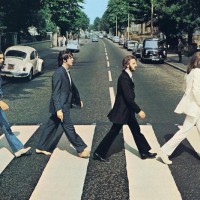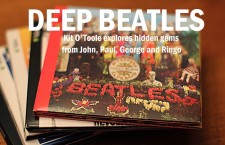The next entry in the Abbey Road medley continues the naughtiness of “Polythene Pam.” While John Lennon told the story of a sexually adventurous and androgynous figure, “She Came in Through the Bathroom Window” is loosely based on an overzealous McCartney fan.
This time, McCartney’s lyrics are opaque, veering from the title phrase to an unusual tale of a somewhat scandalous woman. Even George Harrison admitted in 1969 that it was “a very good song of Paul’s, with good lyrics. It’s really hard to explain what they’re about.” No matter the vagueness, the track rocks hard with stellar McCartney bass, Ringo Starr’s heavy drums, and the group’s usual outstanding harmonies.
“She Came in Through the Bathroom Window” dates back to the Get Back sessions, when McCartney brought the song to the band in January 1969. According to several sources, the story stems from an incident regarding fans breaking into McCartney’s home. A group of women informally dubbed “Apple Scruffs” by Harrison would congregate outside the Beatles’ homes, Abbey Road Studios, and Apple headquarters, hoping to catch a glimpse of their idols. Most of these fans were benign — some were invited into the Beatles’ homes, while two were even recruited to sing backup on a version of “Across the Universe.”
However, a few Apple Scruffs decided to break into McCartney’s house by taking a ladder from his garden, leaning it against his home, and crawling through the bathroom window to obtain some “souvenirs” such as clothing and photographs. Other versions involve McCartney learning of a groupie climbing through a bathroom window to sleep with a member of the Moody Blues; band members told the Beatle of the incident the next day, inspiring McCartney to compose the track.
Lennon offered yet another explanation of the lyrics in a 1980 interview, stating that McCartney composed the lyrics while the duo were promoting their newly formed Apple Corps. in New York during a 1968 visit. “That’s Paul’s song. He wrote that when we were in New York … and we first met Linda. Maybe she’s the one that came in the window. I don’t know; somebody came in the window,” he recalled. This seems unlikely, as McCartney first met future wife Linda Eastman in 1967, when Sgt. Pepper’s Lonely Hearts Club Band was released.
In Barry Miles’ biography Many Years from Now, McCartney said that he composed the “so I quit the police department” section while returning home from New York. While sitting in a cab bound for New York’s JFK airport, he noticed the driver’s license on the dashboard. Above the cabbie’s name and photo were the words “New York Police Dept.,” instantly inspiring McCartney to begin the song’s final lyrics with that line.
As the Beatles gathered for the tension-filled Get Back (later Let It Be) sessions in January 1969, they began work on the track. Anthology 3 and numerous bootlegs illustrate how “She Came in Through the Bathroom Window” started life as a slower, bluesier song. Listening to the Twickenham Studio recordings, it is evident that the Beatles struggled with the tune, attempting to integrate guitar and establish the tempo. Typical of the Get Back sessions, the group would lessen frustration by joking around, intentionally singing words in cartoonish ways. As has been well documented, the Beatles soon shelved this material and focused on recording their final studio album, Abbey Road.
Not surprisingly, “Polythene Pam” and “She Came in Through the Bathroom Window” were recorded together. On July 25, 1969, they recorded 39 takes of the basic track at Abbey Road Studios. McCartney played bass, Lennon strummed 12-string acoustic rhythm guitar, Harrison assumed lead guitar, and Starr played drums. At first Lennon and McCartney recorded guide vocals; later that day they added lead vocals and rerecorded the drum and bass parts. Three days later, they returned to the track, laying down a variety of overdubs; according to the Beatles Bible, these additions included more vocals, electric and acoustic guitar parts, more percussion, and electric as well as acoustic piano.
Interestingly, many of these changes were not implemented in the final mixes. The Beatles finished the recording on July 30 by overdubbing yet more percussion and guitar. George Martin and engineers Geoff Emerick and Phil McDonald completed most of the edits, crossfades, and mixes of the track on August 14.
As Lennon yells “look out!” at the end of “Polythene Pam,” “She Came in Through the Bathroom Window” crashes in, McCartney immediately singing the title phrase. While an Apple Scruff may have been the original inspiration, the lyrics quickly veer from that theme. The line “protected by a silver spoon” may suggest an upper-class woman, but he then infantilizes her, adding that “she sucks her thumb and wonders, by the banks of her own lagoon.” What the latter line means is open to interpretation, or perhaps McCartney is daring listeners to decipher the meaning themselves — a pastime in which fans are admittedly all too willing to engage.
Harrison, Lennon and McCartney harmonize powerfully in the chorus, demanding “Didn’t anybody tell her; didn’t anybody see?” Some interpret the next lines, “Sunday’s on the phone to Monday; Tuesday’s on the phone to me” as his neighbors phoning the police after seeing fans break into his home. The lyrics echo “Lady Madonna,” personifying the days of the week. (“Friday night arrives without a suitcase, Sunday morning creeping like a nun. Monday’s child has learned to tie his bootlace…”) Like Lennon, McCartney occasionally returns to tropes such as these in his songwriting.
As Harrison’s guitar pierces through the instrumentation, McCartney suddenly changes his characterization of the woman. She may have an upper class background, but she claims “she’s always been a dancer; she worked at fifteen clubs a day.” Perhaps she has more in common with “Polythene Pam” than previously thought. In his imaginary conversation with her, he said that “she thought I knew the answer” but “I knew what I could not say.” Again, the content of this unspoken question and answer is left to the listener’s imagination.
The aforementioned “police department” section signals the impending conclusion, but also contains, in my opinion, one of the best lines in the Beatles catalog: “And though she tried her best to help me, she could steal — but she could not rob.” Harrison, Lennon, and McCartney cannot resist wordplay, and the latter line exemplifies this technique. The terms “steal” and “rob” may be considered synonyms, but here McCartney suggests subtle connotations. The Oxford English Dictionary defines “steal” as “to take without permission or legal right and without intending to return it,” while “rob” is listed as “to take property unlawfully from (a person or place) by force or threat of force.” In other words, the unnamed woman can surreptitiously confiscate goods, but not through violence.
Is this another reference to the woman being “protected by a silver spoon,” implying privilege? In other words, is McCartney stating that the woman can commit a crime behind one’s back, but not in front of the person? Whether he is stressing weakness or a general lack of character is anyone’s guess. Regardless of meaning, McCartney demonstrates his mastery over composing cryptic lyrics that somehow still make sense.
Besides the mysterious lyrics, “She Came in Through the Bathroom Window” excels because of pure teamwork. McCartney’s complicated bass lines, prominent in the early mix below, prove crucial to Starr’s hard-driving beat. Harrison’s tasteful solos perfectly punctuate the words, while Lennon provides essential harmonies and rhythmic guitar that further accents the percussion. All of these ingredients comprise two minutes of sheer rock and roll, illustrating how despite their personal issues, they were still at the top of their game.
- The Rescued Early Paul McCartney Song That Completed ‘Beatles For Sale’ - December 4, 2024
- A Rare Beatles Cover Proves John Lennon Was Wrong About His Voice - November 26, 2024
- How John Lennon Came Roaring Back on the Beatles’ White Album - November 22, 2023




great stuff, Kit….with upcoming release of “live at the BBc Vol 2, do you of a bootleg set “The Complete BBC Sessions” that was released in 1993?? If so, what would it be worth//